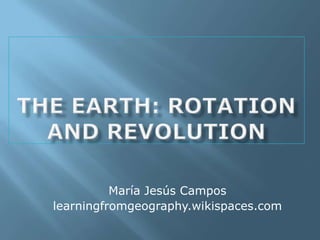
Earth's Movements in the Universe: Rotation and Revolution
- 2. The Earth’s movements in the Universe As a planet the Earth has two movements: It rotates on its axis. This movement is called Rotation. It orbits around the Sun. This movement is called Revolution.
- 3. The Earth rotates around its axis every 24 hours. The Earth’s axis titls at an angle of 23,5º with its orbital plane around the Sun. This movement causes day and night. It is also useful for: Orientation Time zones
- 4. The Earth rotates on its axis every 24 hours. This rotation causes day and night as the Sun’s light only illuminates part of the Earth’s surface while the other part is in darkness. Thanks to rotation, no particular part of the Earth is too hot or too cold,which allows the existance of life on Earth.
- 5. As the Earth rotates on its axis it seems that the Sun moves across the sky. It rises in the East and sets in the West. In fact, it is not the Sun’s motion but the Earth’s rotation which causes this impression. Anyway, this apparent movement of the Sun is often used for orientation on the Earth’s surface. Observing the Sun’s “movement” we can identify 4 cardinal points: North, South, East and West.
- 6. Thanks to the Earth’s rotation we divide the Earth into 24 time zones that correspond to the 24 hours of a day. As the Earth is a geoid of 360º, each time zone is 15º across. There is one hour in a time zone. Spain’s point of reference is the Prime or Greenwich Meridian. This is Meridian at 0º. As we go east crossing time zones, we set the clock forward by one hour. As we go west crossing time zones, we set the clock back by one hour. The Meridian opposite the Prime Meridian is the Meridian at 180º which we call International Date Line because we put the date forward or back by a day when we cross it. All the places located on the same time zone have the same time.
- 8. As a planet, the Earth orbits around the Sun. This elliptical orbit aroun the star is called Revolution. It takes the Earth around 365 days and 6 hours to complete a full revolution around the Sun. The Earth’s Revolution causes: Years and leap years Seasons and a changing length of day and night.
- 10. It takes 365 days and 6 hours for the Earth to complete a full revolution around the Sun. So we have established the length of a year in 365 days. Every four years we sum up the extra 6 hours obtaning an extra day. This is called a leap year as it has a length of 366 days.
- 11. Depending on the position of the Earth in its orbit around the Sun some parts of its surface are closest to the star and some are farthest. The Sun’s rays reach intertropical regions at a direct angle while they reach the poles at much smaller angle. Because of that, different parts of the Earth’s surface receive varying amounts of solar energy. This causes the Seasons: Spring, Summer, Autumn, Winter.
- 12. 21st march Spring in the Northern Hemisphere. Autumn in the Southern Hemisphere 21st June Summer in the Northern Hemisphere. Winter in the Southern Hemisphere Winter in the Northern Hemisphere. Summer in the Southern Hemisphere Autumn in the Northern Hemisphere. Spring in the Southern Hemisphere 23rd September 21st December
- 13. When the Earth is on its closest point to the Sun, we call it an Equinox. The Sun’s rays are vertical at the Equator. Spring equinox takes place on the 21st March and Autumn equinox on the 23rd September
- 14. When the Earth is at its farthest point in its orbit from the Sun we call it a Solstice. It is when the Sun’s rays are vertical at the tropics. Summer solstice takes place on the 21st of June. The Sun’s rays are vertical at the Tropic of Cancer. Winter solstice takes place on the 21st of December. The Sun’s rays are vertical at the Tropic of Capricorn.
- 15. Depending of the position of the Earth in its orbit around the Sun and the tilt of the Earth, some parts of its surface are closest to the star and some are farthest. Some of them receive the Sun’s rays at a direct angle and others at a much smaller angle. Because of that, different parts of the Earth’s surface receive varying amounts of solar energy.
- 17. The Sun’s rays reach intertropical regions at a direct angle for most of the year while they reach the poles at a much smaller angle. The tilt of the Earth’s axis of rotation plus the position of the Earth on its orbit determines the existance of climate zones: Tropics Temperate zones Polar regions
- 19. The tropics are located between the Tropic of Cancer and the Tropic of Capricorn. They receive the greatest amount of solar energy through the year which causes: High temperatures throughout the year Little difference between the seasons.
- 20. The Temperate Zones are located between the tropics and the Polar Circles. So we have 2 temperate zones. The number of daylight hours gradually falls between the summer and the winter solstices. These zones have 4 seasons: spring, summer, autu mn and winter.
- 21. The Polar Regions are located between the Polar circles and the Poles. They receive little solar energy so temperatures are always very low. There are big differences between the length of day and night. The Sun is visible in the sky only for six months of the year in each pole, in the summer. Anyway, even then the Sun provides very little heat because its rays hit the polar regions at a low angle.
- 23. Developed by María Jesús Campos Chusteacher Wikiteacher